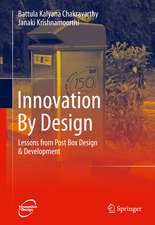Design Synthesis: Integrated Product and Manufacturing System Design
Autor Graeme Arthur Britton, Seppo Torvinenen Limba Engleză Paperback – 28 iun 2018
The biggest challenge in any marketplace is uncertainty. The major changes taking place in world economies, politics, and demographics has raised market uncertainty to its highest level in the past 50 years. However, with new markets opening up in emerging and developing economies, the opportunities have never been better. To compete in this challenging atmosphere, product design/redesign and manufacturing must be integrated to produce better quality products faster and cheaper. Design Synthesis: Integrated Product and Manufacturing System Design provides a conceptual framework and methodologies to do just that.
The book explains how to integrate innovative product design with the design of a batch manufacturing system. It covers the technical and social aspects of integration, presents research and best practices, and embeds integration within a framework of sustainable development. It covers the two methods for achieving design synthesis: integration and harmonisation. Product, manufacturing system, and social system architectures are integrated (united or combined to form a whole that is greater than the sum of the parts). The concurrent processes to design the architectures are harmonised (made compatible or coincident with one another). Wide in scope, the book supplies a multi-disciplinary perspective and an extensive discussion on how to maintain integrity during the design process. The authors present research and practices that are difficult or almost impossible to find. They describe the different types of system lifecycles and include guidelines on how to select the appropriate lifecycle for a specific design situation.| Toate formatele și edițiile | Preț | Express |
|---|---|---|
| Paperback (1) | 329.91 lei 6-8 săpt. | |
| CRC Press – 28 iun 2018 | 329.91 lei 6-8 săpt. | |
| Hardback (1) | 851.82 lei 6-8 săpt. | |
| CRC Press – 28 oct 2013 | 851.82 lei 6-8 săpt. |
Preț: 329.91 lei
Preț vechi: 424.46 lei
-22% Nou
63.15€ • 68.62$ • 53.08£
Carte tipărită la comandă
Livrare economică 21 aprilie-05 mai
Specificații
ISBN-10: 1138073741
Pagini: 382
Ilustrații: 84
Dimensiuni: 156 x 234 mm
Greutate: 0.45 kg
Ediția:1
Editura: CRC Press
Colecția CRC Press
Cuprins
Notă biografică
Seppa Torvinen is a Professor of Production Engineering at Tampere University of Technology, Finland. His areas of interest and expertise are Production Systems Design, Demand Driven Supply Networks, Industrial information systems, Sustainability and Socio technical Systems Design.
Recenzii
—Marco Macchi, in Production Planning & Control, 2016, Vol. 27, No. 4, 343
Descriere
The biggest challenge in any marketplace is uncertainty. The major changes taking place in world economies, politics, and demographics has raised market uncertainty to its highest level in the past 50 years. However, with new markets opening up in emerging and developing economies, the opportunities have never been better. To compete in this challenging atmosphere, product design/redesign and manufacturing must be integrated to produce better quality products faster and cheaper. Design Synthesis: Integrated Product and Manufacturing System Design provides a conceptual framework and methodologies to do just that.
The book explains how to integrate innovative product design with the design of a batch manufacturing system. It covers the technical and social aspects of integration, presents research and best practices, and embeds integration within a framework of sustainable development. It covers the two methods for achieving design synthesis: integration and harmonisation. Product, manufacturing system, and social system architectures are integrated (united or combined to form a whole that is greater than the sum of the parts). The concurrent processes to design the architectures are harmonised (made compatible or coincident with one another).
Wide in scope, the book supplies a multi-disciplinary perspective and an extensive discussion on how to maintain integrity during the design process. The authors present research and practices that are difficult or almost impossible to find. They describe the different types of system lifecycles and include guidelines on how to select the appropriate lifecycle for a specific design situation.
























